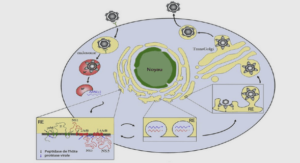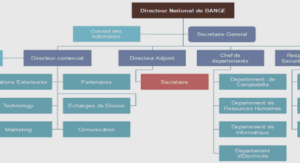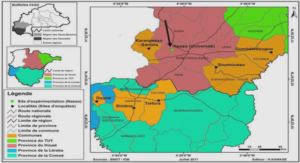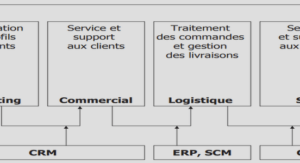Déformation, hydratation et anisotropie du manteau lithosphérique sous un rift actif
Le rifting est un processus complexe entraînant l’amincissement d’une plaque continentale. Bien que le manteau représente plus de 60% de la lithosphère, peu de choses sont connues sur le rôle du manteau sur l’initiation du rifting, mais aussi sur la façon dont le manteau accommode la déformation durant le rifting. Vauchez et al. (1997) et Tommasi et Vauchez (2001) suggérèrent que l’extension continental se produit sous un régime de déformation en transtension produit par la réactivation d’ancienne OPR de l’olivine préservée dans la lithosphère. En plus de subir à des forces extensives, la lithosphère est soumise à une percolation extensive de magmas. Buck (2006) proposa ainsi que l’intrusion de filons pourrait aider à initier l’extension au cœur de la lithosphère continentale. Le travail présenté dans ce chapitre repose sur l’analyse de 53 xénolites mantelliques de la Divergence Nord Tanzanienne provenant de 4 localités différentes : deux au cœur du rift Est-Africain (Pello Hill et Eledoi) et deux au cœur de la ceinture volcanique transverse (Lashaine et Olmani). Cette étude est basée sur la caractérisation des microstructures, des OPRs, des teneurs en hydrogène dans l’olivine des xénolites tanzaniens, ainsi que sur le calcul de leurs propriétés sismiques. Elle vise à mieux comprendre les relations entre déformation et percolation de fluides et magmas au début du rifting ainsi que son régime de déformation. L’analyse de ces échantillons révèle une variation significative des microstructures et des OPRs en fonction de leur provenance. Au cœur du rift, les microstructures porphyroclastiques et mylonitiques enregistrent une déformation par fluage dislocation récente, ainsi que de fortes variations de température. Les cristaux d’orthopyroxène très étirés dans les mylonites suggèrent une initiation de la déformation à faible contrainte et probablement basse température. Le remplacement de l’orthopyroxène par l’olivine dans les péridotites porphyroclastiques et mylonitiques indique des réactions magmas-roches syncinématiques et une déformation se poursuivant sous des conditions proches du solidus.Enfin, les exsolutions dans les orthopyroxènes suggèrent un refroidissement important avant extraction des xénolites. Les OPRs de l’olivine de type axial-[100] et l’orientation des directions de polarisation des ondes SKS suggère que le rift s’est formé sous un régime en transtension (Vauchez et al., 2000). Au cœur de la ceinture volcanique transverse, à Lashaine, les microstructures granulaires à gros grains indiquent une déformation par fluage dislocation à faibles contraintes déviatoriques suivie par du recuit. Les OPRs de l’olivine de type orthorhombique à axial-[010] peuvent être associées à la formation de la chaîne Mozambique ou un événement plus ancien (probablement Archéen, Gibson et al., 2013). A Olmani, des microstructures et des OPRs intermédiaires sont observées, suggérant une déformation hétérogène au sein de la ceinture volcanique transverse, probablement lié au développement du graben de Pangani. Les teneurs en hydrogène dans l’olivine sont comprises entre 2 et 18 ppm wt. H2O, mais ne varient pas en fonction de la localité, de la microstructure ou du type d’OPR. La présence d’hydrogène dans l’olivine au Mg# élevé suggère une réhydration par métasomatisme. Toutefois, l’absence de corrélation spatiale entre les veines tardives et les teneurs en hydrogène dans l’olivine et l’absence de profil de diffusion dans l’olivine indiquent que l’hydratation de ces échantillons n’a eu lieu ni durant cet épisode métasomatique, ni durant l’extraction des xénolites à la surface.
Geological setting
The East African Rift is one of the few active continental rifts on Earth. It extends over ~ 4000 km, from the Afar triple junction in the Red Sea to the Gulf of Mozambique (Fig. 1), mostly following the trend of older orogenic belts (Nyblade and Brazier, 2002; Vauchez et al., 1997 and references therein). Rifting and volcanism started 35 Ma ago in Ethiopia and northern Kenya (MacDonald et al., 2001; Morley et al., 1992) in a lithosphere stabilized since the Neoproterozoic. It migrated southwards, reaching southern Kenya 8-5 Ma ago (Cerling and Powers, 1977; Crossley and Knight, 1981). The youngest section of the East African Rift splits into two branches around the Tanzania craton. In the Eastern branch, extension is accompanied by intense magmatic activity concentrated within the rift valley. The region experiences relatively intense present-day seismic activity, with earthquakes mainly located within the rift valley or in its immediate surroundings (e.g., Albaric et al., 2010; Nyblade et al., 1996). A major faulting episode at 1.0 ± 0.2 Ma (MacIntyre et al., 1974) gave rise to the present-day rift valley morphology. In addition, off-axis volcanic activity is observed in the North Tanzanian Divergence, south of which rifting occurs in a more diffuse manner, with deformation accommodated in many branches (Figure 1). Seismic studies show that crustal and lithospheric thicknesses in this young rifting domain vary between 36-44 km and 100-150 km, respectively (Dugda et al., 2009; Julià et al., 2005). Mantle xenoliths occur in both in- and off-axis volcanoes, providing an exceptional opportunity to study the tectono-thermal evolution of the mantle lithosphere in response to the progression of the East African Rift along the boundary between the Tanzanian craton and the N¬eoproterozoic Mozambique Belt. The present study focuses on 53 mantle xenoliths from four localities from the North Tanzanian Divergence (Fig. 1): two within the rift valley (Pello Hill and Eledoi) and two within the transverse volcanic belt (Lashaine and Olmani). The xenoliths from the cratered tuff cone of Pello Hill and from the Eledoi explosion crater were collected in fine-grained scoria with a bulk-rock chemistry similar to olivine-melilitites and olivine-nephelinites (Dawson and Smith, 1988). The formation of these craters postdates the major rift faulting episode at 1.2 Ma (Dawson and Smith, 1988). The Lashaine tuff cone and the Olmani cinder cone are ankaramite rift-related volcanoes erupted during the Neogene. They are located in a part of the Mozambique Belt characterized by Archean crustal material reworked in the Neoproterozoic by the Mozambique orogeny (Mansur et al., 2014 and references therein; Möller et al., 1998).
Pressure and temperature estimates
Major elements composition of olivine, orthopyroxene, clinopyroxene, garnet, and spinel were analyzed in 15 samples using a Cameca SX100 electron microprobe at Microsonde Sud facility, in Montpellier (France). Analytical conditions were a 20 kV accelerating voltage and a 10 nA probe current. Core and rim composition of 3 to 4 grains were measured for each mineral (mineral compositions of the analyzed samples presented in the online Supplementary Material Table 1). When orthopyroxene and clinopyroxene were both present, the sample equilibrium temperature was calculated using the two pyroxenes Fe-Mg exchange geothermometer from Brey and Köhler (1990), which has an uncertainty of ±50°C. However, many of the samples are clinopyroxene-free harzburgites to dunites. To verify if other thermometers (Brey and Köhler, 1990; Fabriès, 1979; Li et al., 1995; Sachtleben and Seck, 1981; Wells, 1977; WittEickschen and Seck, 1991) could be used to calculate the equilibrium temperatures for the clinopyroxene-free peridotites, the consistency between the temperatures calculated with the two pyroxenes geothermometer of Brey and Köhler (1990) and these thermometers was tested for the clinopyroxene-bearing peridotites. Because the discrepancies between the equilibrium temperatures obtained using different thermometers were large, we choose not to present temperatures calculated for the clinopyroxene-free samples. The equilibrium pressure was estimated in one garnet-bearing harzburgite from Lashaine (LS11) using the orthopyroxenegarnet barometer of Nickel and Green (1985), which has uncertainties of 0.2 GPa.
Electron-backscattered diffraction (EBSD)
The crystallographic preferred orientation (CPO) of olivine, pyroxenes, pargasite, phlogopite, spinel, and garnet was measured by indexation of electron back-scattered diffraction (EBSD) patterns at the SEM-EBSD facility, Geosciences Montpellier. These patterns are produced by interaction of a vertical incident electron beam and a carefully polished thin section tilted at 70° to the horizontal. Measurements were performed in a JEOL JSM 5600 scanning electron microscope using an acceleration voltage of 17 kV and a working distance of 23 mm. For each sample, maps covering nearly the entire thin section were obtained using steps between 100 and 30 µm, depending on grain size. Indexing rates varied between 60 to 90% depending of the mineral species and degree of fracturing present in the thin section. Phlogopite, when present, was usually poorly indexed. Orthopyroxene was sometimes misindexed as clinopyroxene. Careful post-acquisition data treatment controlled by comparison between EBSD maps and microscopic observations was performed to reduce inaccurate mineral determination as well as misindexation due to olivine pseudosymmetry. Modal composition, grain sizes, and shape-preferred orientations were also obtained from the EBSD maps. Crystal-preferred orientation data are displayed in pole figures, presented as lower hemisphere stereographic projections. Data were plotted as one point per grain to prevent overrepresentation of large grains. When the foliation and lineation could be identified, the orientation of the main crystallographic directions: [100], [010] and [001] for olivine and pyroxenes, was plotted relatively to the principal axes of the deformation ellipsoid X, Y, and Z. Because the foliation and lineation could not be identified in coarse-grained samples, thin sections were cut in random orientations. To make comparison between different samples easier, we rotated the CPO of randomly oriented samples into a common orientation in which the maximum concentration of olivine [100] and [010] axes are parallel to the E–W and the N–S directions of the pole figure, respectively.





